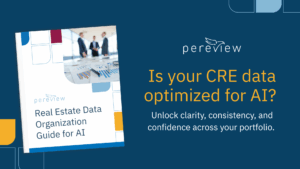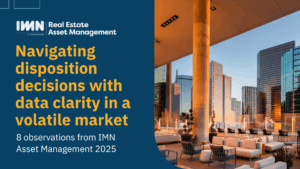The multifamily reporting cycle never stops. Leasing updates, budget tracking, quarterly investor packages, board presentations, and mid-cycle requests all demand attention. When your data is spread across multiple systems, every deliverable starts with the same manual grind: exporting, formatting (or reformatting), double-checking, and hoping the numbers match.
With the right tools, reporting becomes less about chasing data and more about using it – making the process faster, more consistent, and far less stressful.
1. Fragmented data across systems
The challenge: Rent rolls live in Excel files and PDFs. Budgets sit in Excel. Construction and value-add updates are buried in email threads. And by the time you combine it all, the data is already stale.
The solution: Centralizing asset, lease, financial, and construction data in one place means you’re always pulling from the most current information. Whether you need a tear sheet for an investor call, a business plan update for your leadership team, or a quarterly package for your LPs, it’s ready without manual reconciliation.
2. Manual, time-consuming reporting
The challenge: Even standard reports take hours to compile. For example, creating a quarterly board deck for a 15-property portfolio can involve pulling rent growth data from one source, budget vs. actuals from another, and leasing pipeline updates from a third.
The solution: With pre-built templates and live data, those same reports can be generated in minutes – formatted, populated, and ready to review. The structure is consistent every time, so you spend your time on the story behind the numbers, not assembling the slides.

3. Limited visibility into performance drivers
The challenge: Spotting rent growth trends, monitoring lease trade-out performance, or tracking how you’re pacing against a business plan often requires combing through spreadsheets and running manual calculations.
The solution: Reports like lease trade-out summaries and budget variance analyses update automatically. Tear sheets can display side-by-side comparisons of current metrics and historical performance, so you can see exactly where you’re outperforming or falling behind – in time to do something about it.
4. Cumbersome lease and portfolio oversight
The challenge: Tracking expirations, renewals, and lease-up progress manually can lead to missed opportunities, especially during value-add projects or new development lease-ups, where every day of vacancy matters.
The solution: Portfolio-level dashboards and occupancy reports give you a real-time view of leasing health. You can quickly see if a property is underperforming, understand why, and address it with the property management company before the issue grows.
5. Inconsistent investor communication
The challenge: Every investor or stakeholder wants updates in their preferred format – monthly tear sheets, quarterly asset management reports, or annual business plan reviews – which adds complexity to an already full workload.
The solution: Standardized reporting packages make it easy to deliver the right information to the right audience, every time. With consistent formatting and up-to-date data, you can respond to requests without starting from scratch.
The bottom line
Simplifying multifamily reporting enables faster decision-making, stronger investor communication, and more time to focus on strategy. For multifamily portfolios – with large volumes of data and fast-moving leasing cycles – streamlining the reporting process can be the difference between reacting to performance and leading it.



